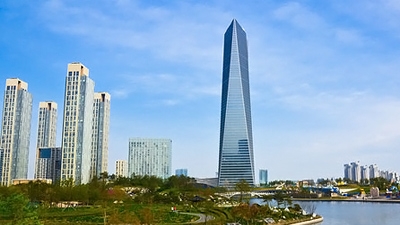Shifting Course
Korea’s economic development during the last century was swift, but it initially overlooked the environment.
Korea moved from an impoverished, war-torn country to an economic powerhouse and the world’s 15th largest economy in less than 50 years. It used an aggressive export policy to become one of the world’s most competitive economies, dominant in automobile manufacturing, ship-building and electronics. It is also became a case study of the need to change historical patterns of production and consumption, and to more efficiently use and manage natural resources. Korea’s meteoric growth lifted living standards, but its greenhouse gas emissions almost doubled between 1990 and 2005, the highest growth rate among OECD countries.
Today, Korea is showcasing green growth in action and is aiming to be a leader in green technology.
In Songdo, for example, Korea is building a digitally-connected city that comprehensively intertwines physical and technological infrastructure on 1,500 acres.
Designed to set the standard for urban centers and become a regional trading hub, Songdo might be one of the first truly “smart” cities in the world. It embodies the need to build up rather than out to reduce costly road construction, reliance on single-person transportation, productivity loss, pollution and wasted energy. Grey water from baths and sinks will be recycled on-site; and a subway system, water taxi fleet, bike and car sharing services, and buses powered by renewable energy fuel cells are designed to limit traffic.
Spreading Green Growth
Korea is also leading by example. It has quadrupled its foreign assistance budget since 2000, to US$800 million in 2009, and it has pledged to boost financing of green energy, conservation and development projects to 30 percent of the total aid budget by 2020.
Some of its outreach efforts include:
Technology: Developing countries suffer disproportionate losses from storms and weather-related natural disasters, due in part to a lack of adequate of forecasting capability. This is especially true in Sri Lanka, which has been ravaged by landslides, flooding and a tsunami. Knowing what the weather is going to be like has a great bearing on human activity patterns, for engineers and public safety officials to devise solutions and sound alerts, deciding when to plant, irrigate and harvest or head out to sea to fish.
The Korean government recently finalized the installation of a COMS (Communications, Ocean and Meteorological Satellite) system to help Sri Lanka by allowing officials to share data, analysis, and forecasting capability.
The system is part of the East Asia Climate Partnership, a US$200 million initiative announced in 2008 to bring Korea’s know how and resources to foster green growth, adaptation and improved resource management to developing countries.
Water: Azerbaijan is plagued by upstream industrial pollution of the Kura-Araks River and insufficient groundwater resources. Only 50 percent of the population has access to piped water. The Korea International Cooperation Agency has pledged to build reservoirs and treatment facilities that will clean, recycle and better manage water resources for more than 300,000 people.
The aid agency is also committed to sharing water management technology and constructing dams and irrigation channels needed to efficiently and effectively sustain agricultural production in the Philippines, where agricultural production has decreased dramatically due to sustained drought.
Policy Advice: The Global Green Growth Institute is an outgrowth of President Lee Myung-bak’s commitment to next generation energy sources and technologies in order create the kind of growth necessary to stamp out poverty without a heavy environmental footprint. The institute’s catalyzes innovation from subnational and sectoral sources, offering a policy laboratory intersection for leaders of industry, finance, academia and government.
Another center, the OECD Korea Policy Center, established in 2007, fuses the expertise of four disciplines to provide tax, economic, governance and health policy advice to enhance the competitiveness of developing nations in the Asia-Pacific region.
"As responsible members of the global village, we have an obligation to work together in order to fight climate change, and take action to make sustained prosperity on Earth possible, not only for the current generation, but also for generations to come," Korea's Presidential Committee on Green Growth states on its website. "The future of our nations today, and of humanity tomorrow, depends on how we respond to climate change now."


